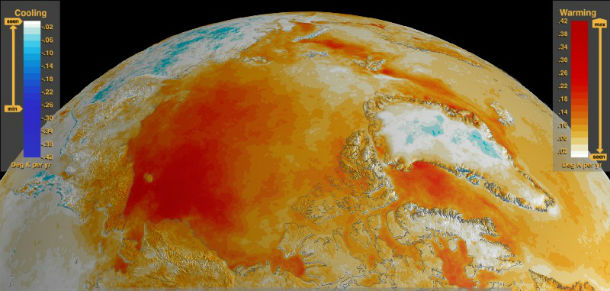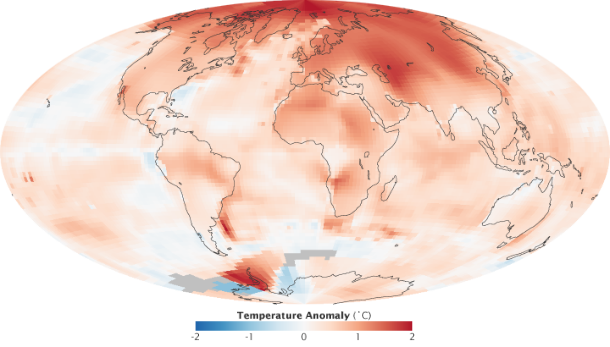Arctic amplification

Since the mid-20th Century, average global temperatures have warmed about 0.6°C (1.1°F), however, warming has not occurred equally everywhere. Temperatures have increased about twice as fast in the Arctic as in the mid-latitudes, a phenomenon known as “Arctic amplification.”
The map bellow shows global temperature anomalies for period of 2000 to 2009. It depict how much warmer or colder a region is compared to the norm for that region from 1951 to 1980. Global temperatures from 2000–2009 were on average about 0.6°C higher than they were from 1951–1980. The Arctic, however, was about 2°C warmer.

Credit: NASA image by Robert Simmon, based on GISS surface temperature analysis data including ship and buoy data from the Hadley Centre. Caption by Adam Voiland.
The global temperature mainly depends on how much energy the planet receives from the Sun and how much it radiates back into space. The amount of energy radiated by the Earth depends significantly on the chemical composition of the atmosphere, particularly the amount of heat-trapping greenhouse gases.
The loss of sea ice is main cause of faster Arctic warming. Losing sea ice reduces Earth’s albedo or the ratio of the outgoing solar radiation reflected by an object to the incoming solar radiation incident upon it. The ocean surface absorbs more heat from the Sun than the surface of snow and ice, so with melting of ice that reflects heat and light from the Sun, darker ocean is getting opportunity to amplify the warming trend , with a surface absorbs heat from sunlight rather than reflecting it back to space.

Compared temperature anomalies for periods between 1880-1889 (left) and 2000-2009 (right) (Credit: NASA/GIS)
The storms transport heat from the surface to higher levels of the atmosphere, where global wind patterns sweep it toward higher latitudes. The abundance of thunderstorms creates a near-constant flow of heat away from the tropics, a process that dampens warming near the equator and contributes to Arctic amplification.
In the past decade (2000-2009), land temperature changes are 50 % greater in the United States than ocean temperature changes, two to three times greater in Eurasia and three to four times greater in the Arctic and the Antarctic Peninsula. Warming of the ocean surface has been largest over the Arctic Ocean, second largest over the Indian and Western Pacific Oceans, and third largest over most of the Atlantic Ocean.
Polar amplification is not observed in the Antarctic, largely because the Southern Ocean acts as a heat sink and the lack of seasonal snow cover.
Sources: NSDIC, GISTemp, Earth Observatory, OSS, CarbonBrief
Featured image: Arctic surface temperature trends 1981–2008 (Courtesy: NASA/Goddard Flight Center Scientific Visualization Studio)

Curious article when all indicators show that the Earth is cooling. So, one has to assume that article only tries to reinforce a theory that has no real science behind to support it and with a lot of flaws. More curious when IPCC has already recognize that global warming has ended in the late 90 of last century.